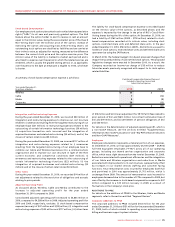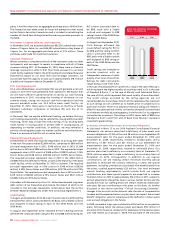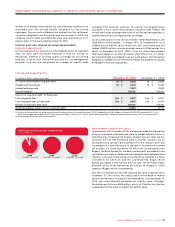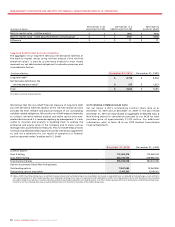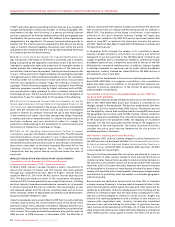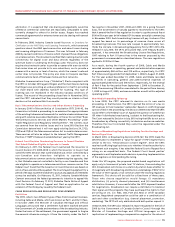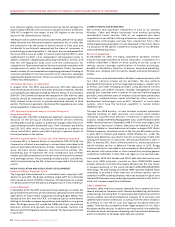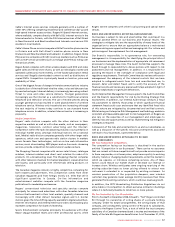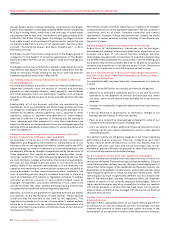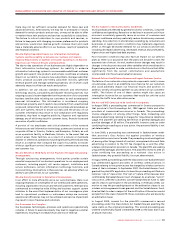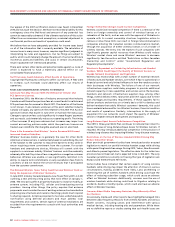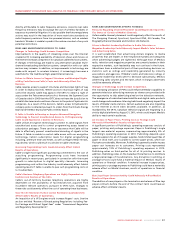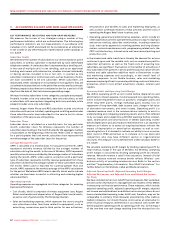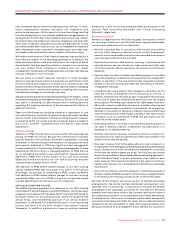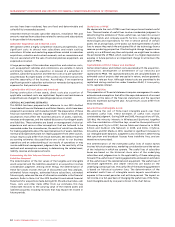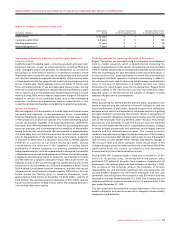Rogers 2010 Annual Report Download - page 51
Download and view the complete annual report
Please find page 51 of the 2010 Rogers annual report below. You can navigate through the pages in the report by either clicking on the pages listed below, or by using the keyword search tool below to find specific information within the annual report.
ROGERS COMMUNICATIONS INC. 2010 ANNUAL REPORT 55
MANAGEMENT’S DISCUSSION AND ANALYSIS OF FINANCIAL CONDITION AND RESULTS OF OPERATIONS
arbitration. It is expected that site-sharing arrangements would be
offered at commercial rates that are reasonably comparable to rates
currently charged to others for similar access. Rogers has reached
commercial agreements for antenna tower and site sharing with several
new entrants.
In February 2008, Industry Canada issued Responses to Questions for
Clarification on the AWS Policy and Licencing Frameworks, which answered
questions about the AWS spectrum auction and about tower sharing
and roaming obligations of licencees. This was followed in February
2008 by revised conditions of licence which imposed those obligations
on wireless carriers. The documents clarified that roaming must provide
connectivity for digital voice and data services regardless of the
spectrum band or underlying technology used. The policy does not
require a host network carrier to provide a roamer with a service which
that carrier does not provide to its own subscribers, nor to provide a
roamer with a service, or level of service, which the roamer’s network
carrier does not provide. The policy also does not require seamless
communications hand-off between home and host networks.
Globalive Communications Corp. (“Globalive”) filed a complaint with
the CRTC in October 2010 against Rogers and the chatr brand, claiming
that Rogers was providing an undue preference to itself in providing
our chatr brand with seamless handoff for roaming. This type of
roaming was not mandated in the Industry Canada conditions of
licence. The record of the proceeding closed late in November 2010,
and the CRTC indicated that they would provide an interim or final
decision on this matter within four months.
Basic Telecommunications Services and Other Matters Proceeding
In January 2010 in Telecom Notice of Consultation CRTC 2010-43, the
Commission initiated a proceeding to re-examine the appropriateness
of the existing forbearance framework for mobile wireless data services
along with wireline issues described below in the section entitled “Basic
Telecommunications Services and Other Matters Proceeding” under
“Cable Regulation and Regulatory Developments”. The wireless issue
was severed from the wireline issues and in a June 2010 Decision the
Commission determined it will now apply existing Sections 24, 27(2),
27(3) and 27(4) of the Telecommunications Act to mobile data services.
These services will also be subject to the Internet Traffic Management
Practices (“ITMP”) framework established last year by the CRTC.
Federal Court Decision Overturning Governor in Council Decision
That Ruled Globalive Eligible to Operate in Canada
On February 4, 2011, the Federal Court overturned the Governor in
Council Decision P.C 2009-2008 in which the Governor in Council had
varied the CRTC Decision that ruled Globalive was in fact controlled by a
non-Canadian and therefore ineligible to operate as a
telecommunications common carrier by determining the opposite, that
is, that Globalive was not controlled in fact by a non-Canadian and thus
was eligible to operate as a telecommunications common carrier. The
Federal Court found that the Governor in Council Decision was based on
errors of law and should be quashed. The Court stayed its judgment for a
period of 45 days to permit Globalive to pursue any appeals and remedies
as may be available. On February 15, 2011, Industry Canada Minister
Clement announced the federal government’s intention to appeal this
Court Decision. On February 17, 2011, Globalive filed a Notice of Appeal
with the Federal Court of Appeal and filed an application for an
extension of the 45 day stay issued by the Federal Court.
CABLE REGULATION AND REGULATORY DEVELOPMENTS
Part II Fees
The CRTC collects two different types of fees from broadcast licencees,
including Cable and Media, which are known as Part I and Part II fees.
In October 2009, the Minister of Canadian Heritage and Official
Languages announced that a settlement had been reached between
the Government of Canada and members of the broadcasting industry.
Under the terms of the settlement, the government agreed to forgive
the amounts otherwise owing to it from the industry under the Part II
fee regime in November 2007, 2008 and 2009. On a going forward
basis, the Government of Canada agreed to recommend to the CRTC
that it amend the Part II fee regulation in order to cap the annual fee at
$100 million per year (with indexed CPI increases annually) commencing
in November 2010. Each broadcasting licencee will pay its share of the
capped fee based on its percentage of revenue share across all
broadcasting licencees. The new rate is equal to approximately two-
thirds the old rate. In Broadcasting Regulatory Policy CRTC 2010-476,
released in July 2010, the CRTC announced that, with Treasury Board’s
approval, it has amended the Broadcasting Licence Fee Regulations,
1997 relating to Part II licence fees in the manner proposed by the
government recommendation described above. The new regulations
applied to 2010 Part II fees.
As a result, during the fourth quarter of 2009, Cable and Media
recorded recoveries in operating, general and administrative expenses
of approximately $60 million and $19 million, respectively, for CRTC
Part II fees covering periods from September 1, 2006 to August31,2009.
For the year ended December 31, 2009, Cable and Media recorded
recoveries in operating, general and administrative expenses of
approximately $46 million and $15 million, respectively, for the reversal
of Part II fees for the period from September 1, 2006 to December 31,
2008. The remaining $18 million was related to the period from January
1, 2009 to August 31, 2009, and was recorded as a credit within adjusted
operating profit.
New Media Proceeding Follow-up
In June 2009, the CRTC released its decision on its new media
proceeding. In that Decision, the CRTC rejected the notion of a tax on
ISP revenues to fund Canadian ‘webisodes’. Based on conflicting legal
opinions filed in the proceeding, the decision determined that the CRTC
would refer to the Federal Court of Appeal the question of whether an
ISP, when it distributes broadcasting, is subject to the Broadcasting Act.
The Court released its Decision in July 2010 ruling that ISPs do not act as
broadcasters by offering connectivity to television and movie websites.
Therefore the Court concluded they cannot be regulated under the
Broadcasting Act.
Review of Broadcasting Regulations including Fee-for-Carriage and
Distant Signal Fees
In March 2010, in Broadcasting Decision 2010-167, the CRTC made the
determination to implement a “value for signal” (“VFS”) regime that is
similar to the U.S. “retransmission consent regime”. Since the CRTC
received conflicting legal opinions as to whether it has the authority to
implement such a regime, it has asked the Federal Court of Appeal for a
ruling on an expedited basis. The Federal Court heard parties’
arguments in mid-September and a decision is pending. Implementation
of the regime is on hold pending the ruling.
Under this VFS regime, the proposed market-based negotiations will
apply only to licencees of private local TV stations, thus excluding the
CBC. Broadcasters will choose on a station-by-station basis whether to:
(1) negotiate with broadcasting distribution undertakings (“BDU”s) for
the value of their signals; or (2) continue under the existing regulatory
framework. This choice will be valid for a fixed term of three years.
Those who choose negotiation would forego: (i) mandatory
distribution; (ii) priority channel placement; and (iii) simultaneous
substitution. However, if unsuccessful after the CRTC-imposed timeline
for negotiations, broadcasters can require a distributor to blackout
their signal and the programs they have purchased the rights to that
are airing on U.S. (i.e. NBC, CBS, FOX and ABC) or other Canadian
services. Negotiated compensation could be cash or a combination of
cash and other consideration (e.g. channel placement, promotion,
marketing). The CRTC will only arbitrate should both parties request it.
In March 2010, the CRTC also released its report requested in the fall of
2009 by the Government of Canada Order-in-Council through the
Minister of Canadian Heritage and Official Languages on the
implications of implementing a compensation regime for the value of


